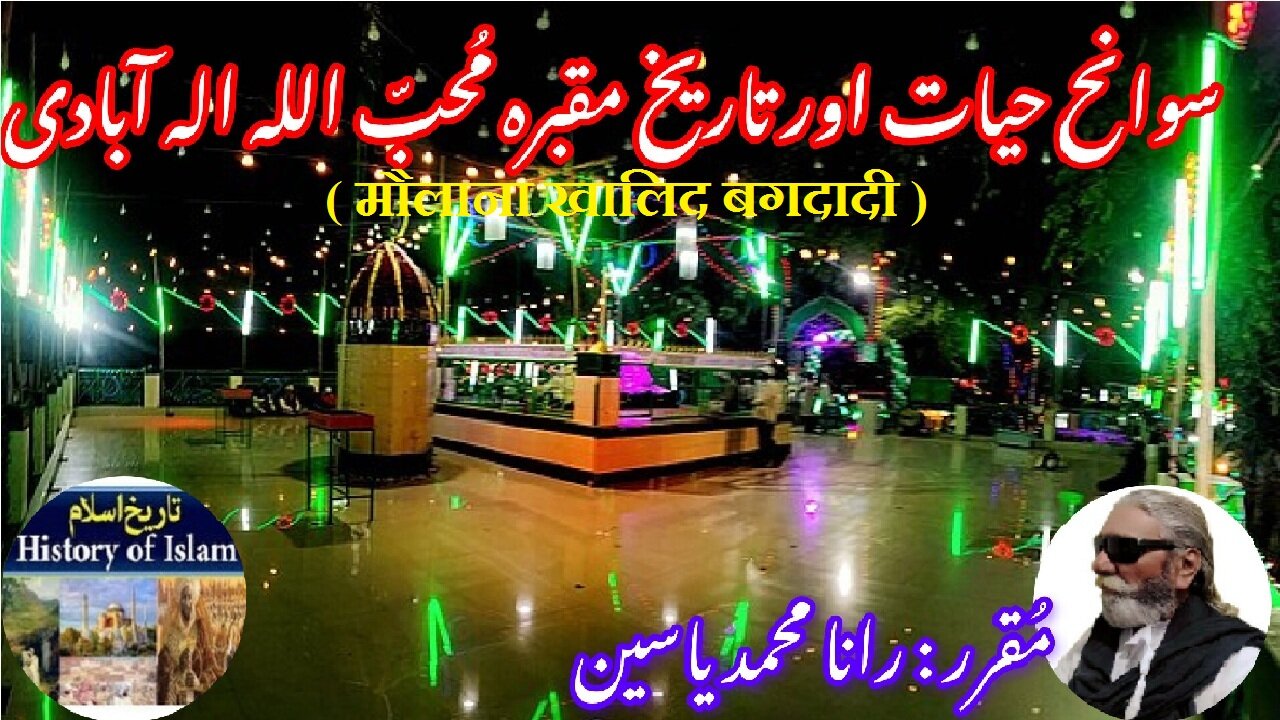Mystic poet Kabir रहस्यवादी कवि कबीर صوفیانہ شاعر کبیر کی سوانح حیات اور ان کے مزار کی تاریخ
@islamichistory813 #sufisaint #culturalheritage #biography #kabir #mystic #poet #sant #islamicmysticism #islamicphilosophy #shrine #historicalfigures
Biography of Kabir mystic poet sant and the history of his shrine
Dekhti Aankhooon aur sountay kaanoon ko Asslamoalaikum, sisters, brothers friends and elders, in informative series videos of Islamic ascolars, sufisaints, cultural heritages, islamic philosophys, islamic mysticisms and historical figures. today we are describing biography of Kabir mystic poet sant and the history of his shrine.
Kabir was a well-known Indian mystic poet and sant. His writings influenced Hinduism's Bhakti movement, and his verses are found in Sikhism's scripture Guru Granth Sahib, the Satguru Granth Sahib of Saint Garib Das, and Kabir Sagar of Dharamdas. Today, Kabir is an important figure in Hinduism, Sikhism and in Sufism.
Born in the city of Varanasi in what is now Uttar Pradesh, he is known for being critical of organized religions. He questioned what he regarded to be the meaningless and unethical practices of all religions, primarily what he considered to be the wrong practices in Hinduism and Islam. During his lifetime, he was threatened by both Hindus and Muslims for his views. When he died, several Hindus and the Muslims he had inspired claimed him as theirs.
Kabir suggested that "truth" is with the person who is on the path of righteousness, who considers everything, living and non living, as divine, and who is passively detached from the affairs of the world. To know the truth, suggested Kabir, drop the "I", or the ego. Kabir's legacy survives and continues through the Kabir panth ("Path of Kabir"), Sant Mat sect that recognizes Kabir as its founder. Its members are known as Kabir panthis.
The years of Kabir's birth and death are uncertain. Some historians favor 1398–1448 as the period Kabir lived, while others favor 1440–1518. Generally, Kabir is believed to have been born in 1398 (Samvat 1455), on the full moon day of Jyeshtha month (according to the historical Hindu calendar Vikram Samvat) at the time of Brahmamuharta. There is a considerable scholarly debate on the circumstances surrounding Kabir's birth. Many followers of Kabir believe that he came from Satloka by assuming the body of light, and incarnated on a lotus flower and claim that the rishi Ashtanand was the direct witness of this incident, who himself appeared on a lotus flower in the Lahartara Pond.
A few accounts mention that Kabir, in the form of in infant, was found at Lahartara Lake by a Muslim weaver named Niru and his wife Nima, who raised him as their child.
Kabir is believed to have become one of the many disciples of the Bhakti poet-saint Swami Ramananda in Varanasi, known for devotional Vaishnavism with a strong bent to monist Advaita philosophy teaching that God was inside every person and everything. Early texts about his life place him with Vaishnava tradition of Hinduism as well as the Sufi tradition of Islam. According to Irfan Habib, the two manuscript versions of the Persian text Dabestan-e Mazaheb are the earliest known texts with biographical information about Kabir. The Dabestan-e-Mazaheb states Kabir is a "Bairagi" (Vaishnava yogi) and states he is a disciple of Ramanand (the text refers to him repeatedly as "Gang").
Kabir's family is believed to have lived in the locality of Kabir Chaura in Varanasi (Banaras). Kabir ma?ha, a ma?ha located in the back alleys of Kabir Chaura, celebrates his life and times. Accompanying the property is a house named Nirutila which houses Niru and Nima graves
Lorenzen in his review of Kabir's philosophy and poetry writes, "the extent to which Kabir borrowed elements from Islam is controversial. Many recent scholars have argued that he simply rejected Islam and took almost all his ideas and beliefs from the Hindu tradition. Contemporary Kabir Panth sadhus make roughly the same argument. Most of the vocabulary used in his songs and verses are borrowed directly from the Hindu tradition. Some scholars state that the sexual imagery in some of Kabir's poems reflect a mystic Sufi Islam influence, wherein Kabir inverts the traditional Sufi representation of a God-woman and devotee-man longing for a union, and instead uses the imagery of Lord-husband and devotee-bride. Other scholars, in contrast, state that it is unclear if Sufi ideas influenced Bhakti sants like Kabir or it was vice versa, suggesting that they probably co-developed through mutual interaction.
Kabir left Islam, states Ronald McGregor. Kabir, nevertheless, criticized practices such as killing and eating cows by Muslims, in a manner Hindus criticized those practices
Kabir literature legacy was promoted by two of his disciples, Bh?god?s and Dharamdas. Songs of Kabir were collected by Kshitimohan Sen from mendicants across India, these were then translated to English by Rabindranath Tagore.
New English translations of Songs of Kabir is done by Arvind Krishna Mehrotra. August Kleinzahler writes about this: "It is Mehrotra who has succeeded in capturing the ferocity and improvisational energy of Kabir’s poetry".
Kabir's legacy continues to be carried forward by the Kabir panth ("Path of Kabir"), a religious community that recognises him as its founder and is one of the Sant Mat sects. This community was founded centuries after Kabir died, in various parts of India, over the seventeenth and eighteenth centuries.Its members, known as Kabir panthis, are estimated to be around 9.6 million. They are spread over north and central India, as well as dispersed with the Indian diaspora across the world, up from 843,171 in the 1901 census.
There are two temples dedicated to Kabir located in Benares. One of them is maintained by Hindus, while the other by Muslims. Both the temples practise similar forms of worship where his songs are sung daily. Other rituals of aarti and distributing prasad are similar to other Hindu temples. The followers of Kabir are vegetarians and abstain from alcohol.
Kabir has been criticised for his depiction of women. Nikky-Guninder Kaur Singh states, "Kabir's opinion of women is contemptuous and derogatory". Wendy Doniger concludes Kabir had a misogynist bias. Schomer states that for Kabir, woman is "kali nagini (a black cobra), kunda naraka ka (the pit of hell), juthani jagata ki (the refuse of the world)". According to Kabir, a woman prevents man's spiritual progress.
With this, we seek your permission until tomorrow, tomorrow we will describe the biography of Muhibullah Allahabadi and the history of his Shrine. Allah Hafiz.
==================
-
 11:03
11:03
Degenerate Jay
3 days ago $0.17 earnedHenry Cavill James Bond Was Almost A Reality
4.58K7 -
 31:58
31:58
CarlCrusher
1 day agoDiscovering the Secret Ultra Low Spectrum for UFO Contact and Skinwalker Ranch
4.08K -
 3:44
3:44
Rethinking the Dollar
1 day agoMichigan’s Big Bitcoin Move—What It Means!
16K1 -
 16:56
16:56
Chris From The 740
14 hours ago $0.19 earnedIs The Ruger RXM A Viable Carry Option? Let's Find Out!
9.19K3 -
 38:28
38:28
Athlete & Artist Show
7 hours ago $6.04 earnedNHL 4 Nations Face Off High Stakes Betting
85.5K5 -
 1:55:41
1:55:41
I_Came_With_Fire_Podcast
13 hours agoAncient Egypt's Rise: Lost Tech, Cult of the Blue Lotus, & Secrets of a Fallen Empire
71.8K15 -
 49:24
49:24
Tactical Advisor
6 hours agoNew Holster & Home Defense Shotgun | Vault Room Live Stream 016
54.3K3 -
 4:44:39
4:44:39
SoundBoardLord
9 hours ago90's Cartoons, Chill Vibes, Good Conversations - SATURDAY MORNINGS WITH CASEY
65.8K3 -
 38:28
38:28
Anthony Pompliano
2 days ago $5.04 earnedPomp on BlackRock & Metaplanet Buying Bitcoin
80.3K -
 36:01
36:01
TimcastIRL
19 hours agoThe Green Room #82 - Timcast Discord & Building Culture in the Digital Space with Roma Nation
98.2K15
